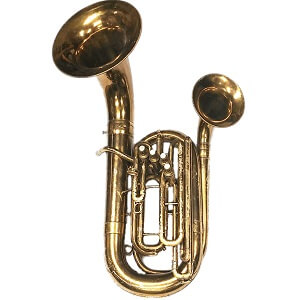Double Bell Euphonium
 These curious instruments, deeply rooted in the American tradition, began to be produced in the United States in the 1880s, with the Conn brand being its precursor. John Philip Sousa introduced them to his band around 1889, and other American bands would follow the example. They possess one euphonium/baritone bell and a smaller one with a more metallic sound, similar to the piston trombone.
These curious instruments, deeply rooted in the American tradition, began to be produced in the United States in the 1880s, with the Conn brand being its precursor. John Philip Sousa introduced them to his band around 1889, and other American bands would follow the example. They possess one euphonium/baritone bell and a smaller one with a more metallic sound, similar to the piston trombone.
The passage from one bell to the other is activated by a piston, which allows switching the bell with great agility. The musical questions and answers, the echo effects or accent combinations offered by this system are unlimited. There are versions with both removable and directional bells and versions with the fixed euphonium bell (upwards) and the directional trombone bell. Their production stopped during the 1960s, after the US military bands officially suspended their use in 1956, since most instrumentalists rarely used the second bell, giving more importance to the weight it added than to the musical resources it offered.
They are probably inspired by the Milanese Duplex of Giuseppe Pelitti. He presented the first prototype in 1847 in a contest organized by the Instituto Lombardo di Szienze, Lettere e Arti, and then a whole family of those in the 1851 edition: a Flugelhorn-Cornet, a Trumpet-Alto Horn in Eb, a Bombardino-Valve Trombone and a Bombardone-(Contra)Bass trombone in F. Adolphe Sax copied this idea and, in the Universal Exhibition of Paris of 1855, he won the first prize for the invention of the Trumpet-Alto Horn in Eb, even ahead of Pelitti himself there, through a series of dirty tricks and games. Later Pelitti would invent versions with 3 bells and even versions with a bell inside the other.